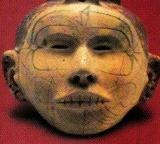BOOK REVIEW
By Elmer A. Guerri, G.I.R.S. Board Member
THE HEADPOTS OF NORTHEAST ARKANSAS AND SOUTHERN PEMISCOT COUNTY, MISSOURI
Author: James F. Cherry


One 01 the most interesting aspects of collecting and studying Indian artifacts today is the availability of excellent reading and study materials. A great example is the 2009 book by James E Cherry, The Headpots of Northeast Arkansas and Southern Pemiscot County, Missouri.
Cherry’s passionate interest in and his extensive knowledge of this unique and important niche of North American Mississippian Indian culture is clearly evident as the reader proceeds from historical findings through a most comprehensive inventory of discussions dealing with 138 identified classical style headpots, to the author’s astute observations regarding modern reproductions.
The author’s thorough research has culminated in a separate section dealing with “Mistakes in the Literature”, an inclusion every reader will be left wishing existed for publications and information dealing with other types of cultural material in North American Archaeology.
Cherry’s style reflects the attention to detail and thoroughness of his professional physician’s background. Extensive discussions of motifs and style characteristics including eye surrounds, facial decorative tattoo patterns, hair patterns and other details are both educational and provocative. His attempts to depend upon “original sources” accomplishes his stated goal “…..to present unbiased facts.”
The author raises some very interesting questions for the reader, such as,
“Do headpots portray kinsmen or enemies? The living or the dead? Were the headpots used in ceremonies, in everyday life, or made exclusively for the sepulcher?”
The reader will have to reach his or her own conclusions, based upon the information provided by the author.
Perhaps the most fitting compliments to this outstanding book are found in the Foreword provided by Robert C Mainfort, Jr., an archaeologist with the Arkansas Archaeology Survey and a professor of anthropology at the University of Arkansas. “Jim’s status as a physician and avocational archaeologist (though this volume should warrant an honorary degree in archaeology!) gave him access not only to privately owned headpots, but also to their history. Moreover, that Jim was accorded this level of trust is a testament to his personal character.”
This a great work and a “must have” reference that will take its place alongside other important books dealing with ceramics and pottery. The author includes a comprehensive bibliography with seventy entries, which will be valuable to those interested in the cultural material of North American Indians.
This book has established a “higher bar” that will hopefully challenge other authors, professionals and avocationals alike. In today’s world of collectible ceramics and pottery where it is regrettably often difficult to discern between “new” and “old”, one thing is certain. Cherry’s headpot book may itself be “new”, but it is indeed “the real thing”!
